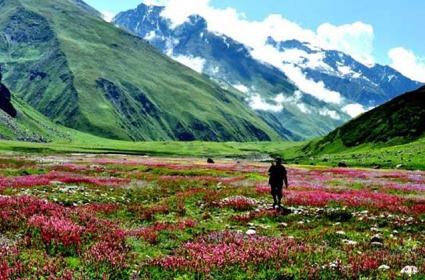Valley Of Flowers And More

By Ravi Valluri
“We can only climb the mountains because there’s a valley that makes the mountain a mountain,” writes the noted psychologist Craig D. Lounsbrough.
A valley is a low area of land lying between hills or mountains, usually with a river or a stream flowing through it, much akin to the landscape of our lives, populated as it is with peaks and valleys.
People dream that one day each valley shall be exalted, every hill and mountain will stretch out to caress victory, the rough places will be made straight and the glory and bounty of divinity will be revealed in their lives.
Without doubt, the one place where a walk through a valley will bring rapturous contentedness is a trek through the Valley of Flowers - a World Heritage Site- in North Chamoli district of Uttarakhand. Neatly nestled among the snow clad peaks of the Himalayas, the state has abundant places of scenic beauty which also offer a bouquet of amazing opportunities for trekking. For those with a religious or spiritual bent of mind Kedarnath, Badrinath, Joshimath, Gangotri and Yamunotri offer ample scope.
The Valley of Flowers trek is usually planned over 4-6 day and is a lifetime chance to witness stunning natural vistas.
The valley is populated with estimable meadows of alpine flowers and a variegated spread of flora and fauna. The rich bio-diversity of the area is also home to recherché and endangered animals, including the Asiatic black bear, the snow leopard, the atypical brown bear, scarce red fox and the blue sheep. Birds inhabiting the park include the rare Himalayan monal pheasant and other high altitude birds.
At about 3352 to 3658 meters above sea level, the gentle landscape of the Valley of Flowers National Park complements the rugged mountain wilderness of Nanda Devi National park to the east. These landmasses encompass a sui generis transition zone between the Zanskar mountain ranges and the robust great Himalayas. The park itself stretches over an expanse of 87.50 km2 and is about 8 km long and 2 km wide.
Though place has been recognized internationally only since about a century back, it finds a pre- eminent place in the the mystique of Hinduism. Since aeons local denizens have visited the valley. Indian rishis and yogis are known to have visited the valley to meditate.
Adi Shankara, who established the Advaita School of philosophy, at a tender age traversed all the way from Kaladi in Kerala to the pristine hills and established the celebrated and venerated temple at Badrinath. Possibly he too visited the Valley of Flowers.
In 1931, Frank S.Smythe, Eric Shipton and R.L Holdsworth, all British mountaineers, lost their way while returning from a successful expedition to Mt Kamet and happened to stumble upon the valley, which was blazing with radiant flowers. The magnetic charm of the area allured them and it was christened the “Valley of Flowers.”
In 1939, Joan Margaret Legge, a botanist deputed by the Royal Botanical Garden, Kew arrived at the valley to examine the rich tapestry and abundance of flowers. While traversing some rocky slopes to collect flowers, tragedy struck as she slipped-off and a precious life was snuffed out. Her sister later visited the valley and erected a memorial near the spot.
The valley has variegated and colourful flowers, taking on various shades of colours with the passage of time. Prof. Chandra Prakash Kala, a botanist deputed by the Wildlife Institute of India, carried out a research study on the floralistics and conservation of the valley for a decade, beginning in 1993.
As one footslogs over peaks and treacherous precipices, the tipper pays obeisance at Sri Hemkund Sahib, among the holiest pilgrimage sites of the Sikhs.
The expeditionary also witnesses natural splendours throughout the grandiose trek. The trek usually begins from Govindghat, about an hour away from Joshimath. From Govindghat the trekkers move to Ghangaria, about 3km away from the valley. Along this route one would find many devout Sikhs on their way to Gurudwara Sri Hemkund Sahib. At Ghangaria one needs to obtain a permit to actually visit the Valley of Flowers. The trip to the valley is permitted only during the day.
The adventurous can plan their itinerary to include more destinations like Haridwar, Joshimath and Rishikesh. Besides undertaking the arduous yet fascinating trek and rafting on the waves of the Ganges near Rishikesh or Haridwar, there are several other standout points and vignettes in the vicinity.
Tour operators tourist agencies make arrangements for travel to Haridwar. The fascinating itinerary is indicative of what could be possible. The tailor-made holiday packages cater to the specific interests of guests. To leave an indelible impression on the minds of the travellers there are several interesting places to visit.
These include a visit to Har-ki-Pauri, witnessing the consecrated evening Ganga Aarti at Haridwar, trips to the Panch Prayag, (Vishnuprayag, Nandaprayag, Karnaprayag, Rudraprayag and Devprayag, which are five points of confluence of the Alaknanda River with other rivers), sightseeing in Rishikesh and its environs.
These are some jaw dropping vignettes to which travellers are exposed and carry with them sublime memories as clouds waft across the panoramic view of swathes of land.
A trip to the Valley of Flowers and other splendid locations would make one firmly believe in the words of American author, John Burroughs, “You are always nearer the divine and the true sources of your power than you think.”
Also Read: Neelakurinji Flower Blooms In all Its Glory After 12 Years In Kerala
Also Read: Singapore Makes World’s Largest Flower Basket For Garden Festival
















